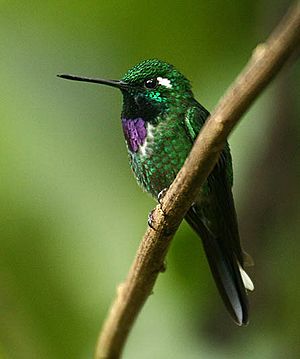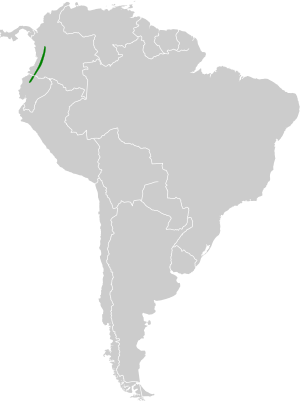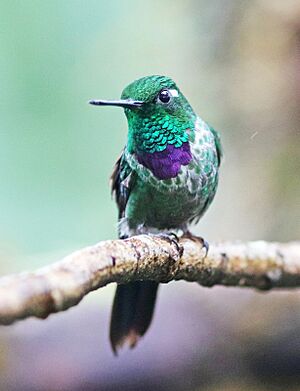Purple-bibbed whitetip facts for kids
Quick facts for kids Purple-bibbed whitetip |
|
|---|---|
 |
|
| A male in Ecuador | |
| Conservation status | |
| Scientific classification | |
| Genus: |
Urosticte
|
| Species: |
benjamini
|
 |
|
The purple-bibbed whitetip (Urosticte benjamini) is a beautiful little hummingbird. It belongs to a group of hummingbirds called "brilliants". You can find this bird living in the countries of Colombia and Ecuador in South America.
Scientists used to think the purple-bibbed whitetip might be the same species as another hummingbird, the rufous-vented whitetip. However, after studying them closely, they now agree that these are two different kinds of birds. Both are the only members of their genus, Urosticte.
Contents
What Does the Purple-Bibbed Whitetip Look Like?
This hummingbird is quite small, usually about 8 to 9 centimeters (about 3 to 3.5 inches) long. It weighs only about 3.8 to 4.2 grams, which is less than a nickel! Both male and female birds have a straight, black beak that is medium-sized. They also have a clear white stripe right behind their eye.
Their upper body feathers are a shiny, glittering green. Male birds have a bright violet color on their lower throat. Below this, their belly is grayish with green spots. Their tail is a dark bronze color. The feathers in the middle of the tail have wide white tips, which look like an oval spot.
Female birds look a bit different. Their underparts are white with many green spots. Their tail is also a dark bronze, but it has purple near the end and white tips on the outer feathers. Young birds look similar to the females, but they have brown edges on the feathers of their head.
Where Do These Hummingbirds Live?
The purple-bibbed whitetip lives on the western side of the Andes mountains. You can find them from the Chocó region in Colombia all the way south into Ecuador. They live in montane forests, which are forests found in mountains.
They prefer to live inside these forests or along their edges. Usually, they are found at heights between 700 and 1600 meters (about 2,300 to 5,200 feet) above sea level. In Ecuador, they are most common at elevations between 1200 and 1400 meters (about 3,900 to 4,600 feet).
How Do Purple-Bibbed Whitetips Behave?
Movement and Migration
In Colombia, these hummingbirds tend to stay in the same area all year round. They don't move much. However, in Ecuador, after they have their babies, they sometimes fly to lower areas.
What Do They Eat?
Purple-bibbed whitetips mostly look for food inside the forest. They search for food from close to the ground up to just below the treetops. Their main food is nectar from different types of flowering plants. These include plants like bromeliads and others from families like Ericaceae, Fabaceae, and Rubiaceae.
Besides nectar, they also eat insects. They catch insects by picking them off plants (this is called gleaning). They also catch insects while flying, by darting out from a perch (this is called hawking).
Reproduction and Life Cycle
In Ecuador, the purple-bibbed whitetip's breeding season is from January to April. We don't know much about their breeding season in Colombia yet.
The female bird builds a cup-shaped nest using moss and ferns. She usually places her nest in a shrub or in vines in a steep valley. The nest is typically about 2 to 4 meters (about 7 to 13 feet) above the ground. The female lays two eggs. She sits on the eggs for 16 to 18 days to keep them warm. We don't know how long it takes for the baby birds to be ready to fly out of the nest.
What Sounds Do They Make?
The purple-bibbed whitetip makes a "mellow, nasal-sounding fast twittering" call. It sounds like "tweetweetweetwee..." and can even sound like a "laughing chatter." When they are flying and feeding, they also make "single lower-pitched scratchy notes," which sound like "chrrrrr." Another call they make is a "very high-pitched 'pseee'."
Is the Purple-Bibbed Whitetip in Danger?
The IUCN (International Union for Conservation of Nature) has said that the purple-bibbed whitetip is a species of "Least Concern." This means they are not currently in immediate danger of disappearing. We don't know exactly how many of these birds there are, but their numbers are thought to be slowly going down.
Even though their population might be decreasing, no big threats have been found right now. They live in a specific area, but they are still considered common in that area. Also, they live in some protected places, which helps keep them safe.
See also
 In Spanish: Colibrí Puntablanca Occidental para niños
In Spanish: Colibrí Puntablanca Occidental para niños



